▌ Sustainable Development Policy


Yieh Hsing follows the management philosophy "Innovation, growth, responsibility, and sustainability" by E United Group and takes "Make profit, strive for better, gain trust" as a guideline for management. Yieh Hsing has been committed to sustainable development since YH was first established. We value three perspectives of corporate governance, environment, and society and actively respond to issues that are concerned by the investors, government, employees, subcontractors, and community.
▌ Sustainable Development Committee
Yieh Hsing Enterprise "Sustainable Development Committee" Organization chart
| Corporate Governance President's Office, Financial Div. |
Resource Management Production Div. at Gangshan and Pingnan |
EHS Management Industrial Safety & Health Room |
Product Responsibil Technology Div. |
Employee and Society Participation Human Resources & Administration Div. |
|
| Development Trend | Internal control, finance and accounting system, operation performance, risk management, financial communication, etc. | Energy saving, water saving, carbon reduction, waste reduction, etc. | Safety & health environment, disaster prevention, environmental responsibility, environmental organization communication, environmental audit and improvement, etc. | Quality ensurance, product environment consideration and design, product environment communication, product safety, technical patent, customer satisfaction, etc. | Manpower recruitment, talents cultivation, labor relations, employee caring, community participation, charity, etc. |
| Management Regulations |
- International Financial Reporting Standards (IFRS) - Corporate Governance Best Practice Principles - Company Act |
- Energy Management System(ISO 50001) |
- Occupational Health and Safety Management Systems (ISO 45001 and CNS 45001) - Environmental management system (ISO 14001) |
- Quality management system(ISO 9001) - Product certification (PED、CNS) |
- Employee health promotion plan - Labor Act - Act of Gender Equality in Employment |
▌ Risk management policies and procedures
▌ Organizational Structure and Responsibilities of Risk Management
| Organization | Duties |
|---|---|
| Board of Directors | The Company's Board of Directors is the highest governance body for corporate risk management, responsible for approving risk management policies and significant risk management systems, with the aim of complying with regulations, promoting, and implementing overall corporate risk management, clearly understanding the risks faced by operations, ensuring the effectiveness of risk management, and bearing the ultimate responsibility for risk management. |
| Audit Committee | Review the effectiveness of the Company's internal controls system, ensure its effective implementation, and monitor the management of existing or potential risks within the Company. |
| Audit Office | Responsible for conducting risk management audits to ensure the effective implementation of internal controls, in compliance with current regulations and control procedures. |
| President and President's Office | The President is responsible for establishing the Company's overall risk management system and supervising the execution and coordination of risk control. The President's Office assists the President in promoting and executing related risk management tasks. |
| Divisions and business execution units | The heads of each division and business execution unit are responsible for identifying the various risks they face and implementing risk management tasks to ensure that the risks involved are controlled within acceptable limits, thereby ensuring the effective operation of risk control mechanisms and procedures. |
▌ Scope of risk management
-
Governance Aspect
- Strategic and Operational
- Regularly report strategic issues and risk conditions to the directors, and mitigate strategic risks through the participation, advice, and supervision of the directors.
- The Sales Division determines the optimal sales strategy based on production costs and overall market trends for both domestic and international sales, striving to maximize order revenue.
-
Laws and Regulations Compliance
- Regularly review the Company's operations for Compliance with laws and regulations, and perform monitoring and updates.
- Notify the responsible divisions of updated regulations to ensure that all activities comply with regulatory requirements.
- The Audit Office periodically examines internal controls and regulations to ensure compliance.
- Establish effective internal controls and strengthen the prevention of compliance risks.
-
Information Security Risks
- The Company established the "Corporate Information Security Management Measures" and related operational guidelines, and irregular reviews them to ensure their appropriateness and effectiveness, thereby reducing the risk of information security hazards.
- Establish a system of permissions and control mechanisms to reduce the risk of confidential data leakage.
- Regularly review the weaknesses of external service systems, and make appropriate improvements, handling, and preventive measures.
- Regularly implement information and communication security training and education, reinforce the promotion of information and communication security policies, and conduct emergency response exercises.
- Regular internal audits of information security shall be conducted to reduce risks and drive continuous improvement..
-
Financial Risks
- Interest Rate Fluctuations
- Diversify the use of short, medium, and long-term financing instruments with different interest rate sensitivities to achieve mitigation of the impact of significant interest rate fluctuations.
- Conduct a prudent evaluation of major capital expenditures to use lower-cost financing tools.
- Maintain a good relationship with banks to secure the best financing and deposit rates.
- Exchange Rate Fluctuations
- The Finance Division must always keep track of exchange rate fluctuations and trend changes in order to fully understand exchange rate movements and decide on the timely conversion of currencies, and the retention of foreign currency deposits or loans.
- The Company has established the "Procedures for Acquisition and Disposal of Assets" to regulate the related operations of trading, risk management, supervision, and auditing of derivative financial instruments, in order to mitigate the transaction risks arising from derivative financial instruments related to exchange rates.
- Consult with the bank's foreign exchange department on hedging strategies, and adjust the level of foreign currency based on actual funding needs and exchange rate fluctuations.
- Raw Materials Management
- Through various external information sources, obtain real-time information on the raw material market.
- Establish a safety stock level and retain a portion of demand to flexibly meet production needs.
- Establish and improve the Company's raw material management. The Company has established the "Procurement, Acceptance, and Claims Management Procedures for Small Steel Products" to further enhance internal risk management.
- Continuously explore and evaluate new suppliers to reduce risks arising from frequent market fluctuations and to strengthen the arrangement and control over production and sales.
- Establish a dedicated unit to conduct intelligence collection, information analysis, and risk assessment, thereby assisting raw material procurement and business units in evaluating the latest market supply and demand conditions and determining the appropriate timing and quantity for raw material procurement.
- Interest Rate Fluctuations
-
Environmental Aspect
-
Risks
- Carbon Emissions Management
- Promote the establishment of ISO 5001 Energy Management System performance indicators to facilitate long-term energy efficiency control.
- Through the Company's ISO 14001 Environmental Management System, ISO 14064-1 Greenhouse gases Part 1: Specification with guidance at the organization level for quantification and reporting of greenhouse gas emissions and removals, and ISO 14067 Carbon footprint of products - requirements and guidelines for quantification, identify high carbon emission activities and solutions to reduce GHG emissions.
- Invest in green power to enhance carbon reduction performance.
- Complete greenhouse gas (GHG) verification in April 2024.
- Reduce environmental pollution and implement energy management
- Continually seek and develop waste reuse technologies to enhance resource recycling rates.
- Reduce the impact on climate change through process technology and fuel replacement.
- Implement effective energy management through the Company's ISO 50001 Energy Management System, which achieves continuous improvement and energy saving as well as carbon reduction.
- Carbon Emissions Management
-
Social Aspect
-
Risks
- Conduct environmental, safety and health functional education and training: Ensure the consistency of the environmental, safety and health management systems across all plants, re-examine and identify workplace operational risks, and continuously improve to reduce incident rates.
- The Company has revised the "Contractor Safety and Health Management" in June, 2020, and demands all sub-contractors and contractors to comply with the rules and regulations governing environmental safety and health for admission to the facilities of the Company so as to reduce the occurrence of hazards.
- Adopt the PDCA management cycle to identify hazards, assess risks, make improvements, and assure performance, and continue to demand the effective implementation of this management system to create a safe and comfortable workplace and achieve the goal of zero injuries in operations.
- Establish a contractor evaluation mechanism, including evaluations of engineering contractors, technical service contractors, and technical seconded personnel, to be carried out by the engineering organizing unit.
▌ Risk Management Operations
- The "Risk Management Policy and Procedures" was approved by the Board of Directors on March 9, 2023.
- Identify risks and propose management mechanisms to monitor the Company's risk tolerance: The Company's risk management process includes elements such as risk identification, risk measurement, risk response, risk monitoring, and risk reporting. In addition to having each division and business unit responsible for identifying the potential impacts various risks may have on the Company, we also propose control mechanisms for managing these risks to monitor the Company's risk tolerance.
- Through internal controls, enable the Board of Directors and Audit Committee to effectively monitor the implementation and control of risks: To actively promote and implement the management mechanism, the Audit Committee is established under the Board of Directors. The Audit Committee is responsible for supervising the effective implementation of the Company's internal controls and the management of potential risks. Each year, audit personnel from the Audit Office conduct risk management audits based on the results of the risk assessment to confirm whether each division and business unit is indeed implementing internal controls and to provide timely improvement suggestions. Based on the aforementioned information, the Company's internal controls system self-evaluation is reported to the Audit Committee annually. On March 7, 2024, the summary report of the 2023 internal controls system self-evaluation and the internal controls statement will be issued.
- Identify potential physical risks and transition risks regarding issues related to climate change: The Company continues to pay attention to international issues related to climate change, identifying potential physical and transition risks to manage and mitigate the impacts of climate-related risks.
- The Company completed the 2023 Greenhouse Gas verification in April, 2024, and set reduction targets and measures based on the inventory results.
-
Since 2023, to implement risk management, the Company reports its operational status to the Board of Directors at least once a year:
On May 6, 2024, the Company reported the "2023 Risk Management Operations of Yieh Hsing Enterprise Co., LTD." to the Board.
▌ Environmental Aspect
Unit:MT CO2e/year
Unit:MT CO2Million NT$
▌ Economic Aspect
▌ People Aspect

In November 2023, the acid pickling plant and the Pingnan Plant were awarded the "Progress Award" for outstanding performance in the safety evaluation by the Taiwan Steel & Iron Industries Association.
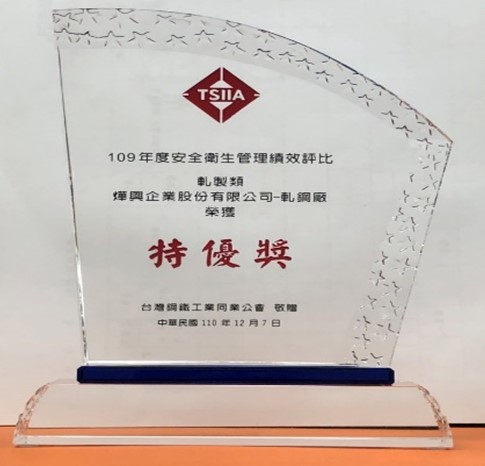
"Excellent Award" by Steel & Iron Industries Association in occupational safety performance evaluation for rolling steel plant in December 2021.
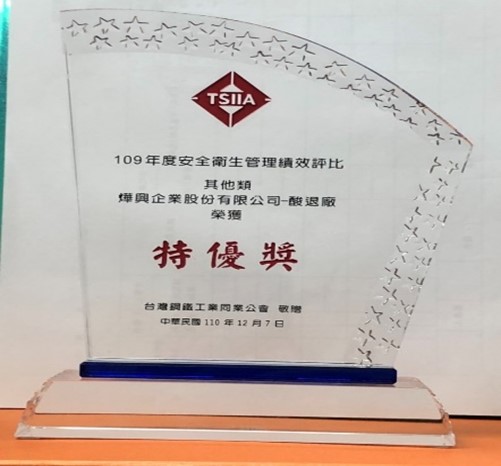
"Excellent Award" by Steel & Iron Industries Association in occupational safety performance evaluation for pickling plant in December 2021.
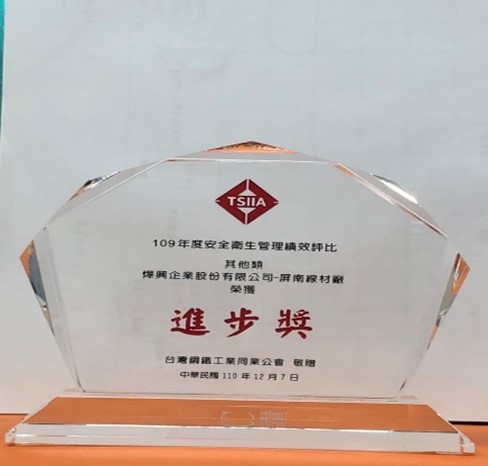
"Improvement Award" by Steel & Iron Industries Association in occupational safety performance evaluation for Pingnan plant in December 2021.

"Excellent Award" by Steel & Iron Industries Association in occupational safety performance evaluation for rolling steel plant in November 2019.
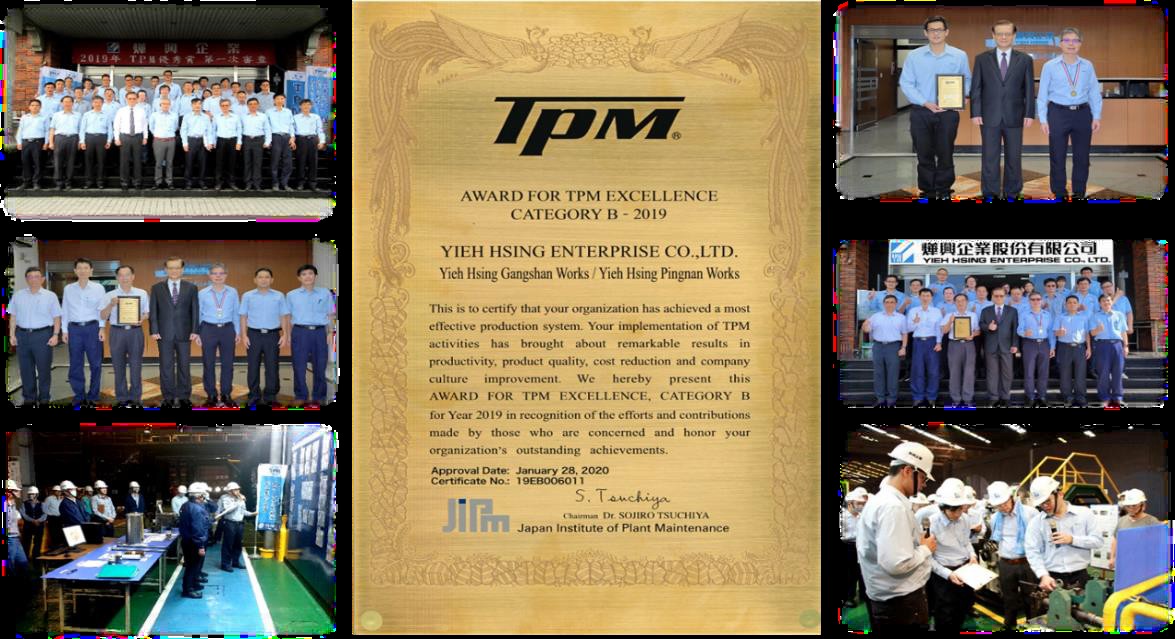
TPM Excellence Award by JIPM in 2020.

Yieh Hsing Enterprise has ranked number 1 in the top 500 corporates by Veterans Affairs Council for assisting veterans on job employment in 2021.
▌ Materiality Assessment Process
▌ Positive and Negative Impact Matrix Diagram
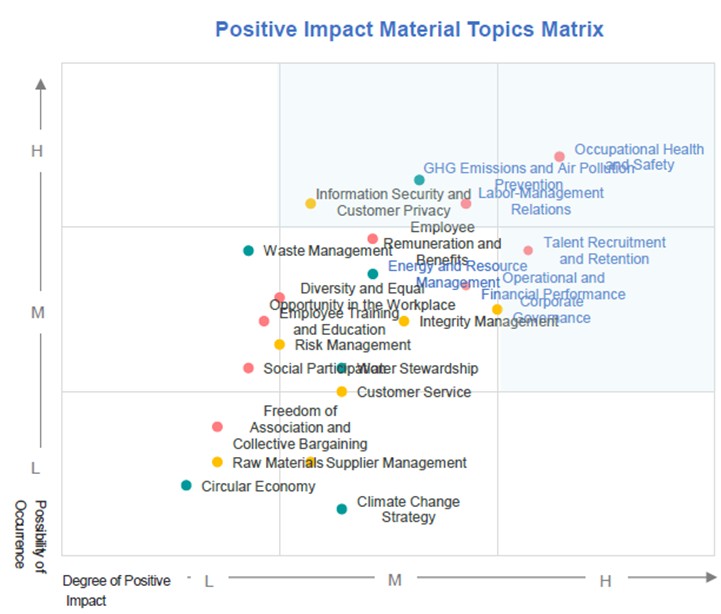
-
Issues with Significant Positive Impacts:
- Environmental Aspect: GHG Emissions and Air Pollution Prevention.
- People (Human Rights) Aspect: Occupational Health and Safety, Labor/Management Relations, Talent Recruitment and Retention.
- Governance and Economic Aspects: Information Security and Customer
-
Secondary impacts:Operational and Financial Performance, Energy and Resource Management, Employee Remuneration and Benefits
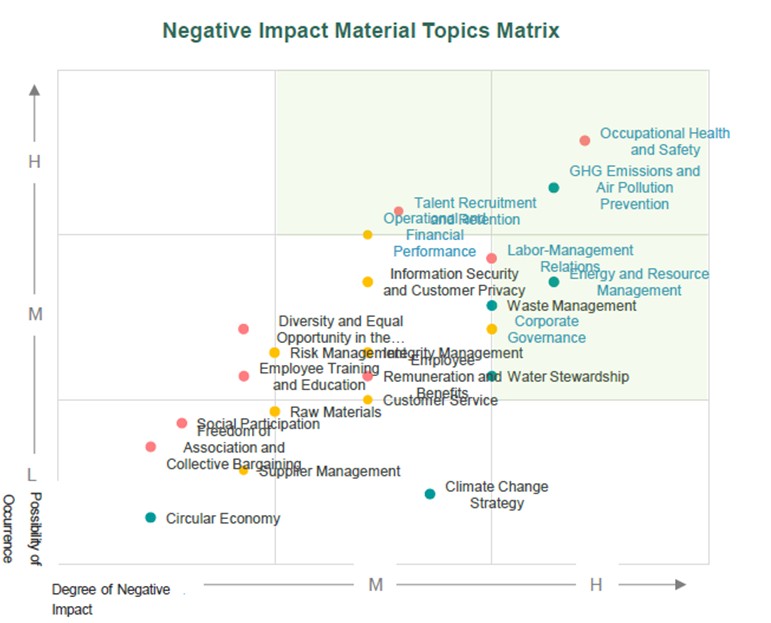
-
Issues with Significant Negative Impacts:
- Environmental Aspect: Greenhouse Gas (GHG) Emissions and Air Pollution Control, Energy and Resource Management, Waste Management, Water Stewardship.
- People (Human Rights) Aspect: Occupational Health and Safety, Labor/Management Relations, Talent Recruitment and Retention.
- Governance and Economic Aspects: Operational and Financial Performance, Corporate Governance.
-
Secondary Impact: Information Security and Customer Privacy.
| Aspect | Material Topics | The scope of value chain impacts | GRI Standards | SASB Standards | Referenced Section | ||
|---|---|---|---|---|---|---|---|
| Economic | Environment | People | |||||
| Environmental Aspect | GHG Emissions and Air Pollution Prevention | ▽ | △ | ▲ | GRI 305: Emissions |
EM-IS-110a.1 EM-IS-110a.2 EM-IS-120a.1 |
4.3 GHG Emissions and Air Pollution Prevention |
| Energy and Resource Management | △ | △ | ▼ | GRI 302: Energy |
EM-IS-130a.1 EM-IS-130a.2 |
4.4 Energy and Resource Management | |
| People Aspect (Human Rights) | Occupational Health and Safety | ▼ | ▽ | ▲ | GRI 403: Occupational Health and Safety | EM-IS-320a.1 | 5.6 Occupational Health and Safety |
| Talent Recruitment and Retention | △ | ▲ | △ | GRI 404: Training and Education |
5.1 Talent Recruitment and Retention 5.4 Competence and Development |
||
| Labor-Management Relations | ▼ | ▽ | △ | GRI 401: Employment | 5.2.3 Labor-Management Relations | ||
| Economic Aspect | Corporate Governance | ▼ | ▼ | ▼ | General Disclosures | 2.1 Corporate Governance | |
| Operational Financial Performance | △ | ▲ | ▼ | GRI 201: Economic Performance | 3.1 Market and Business Conditions | ||
Note: △:Positive actual impact ▽:Positive potential impact ▲:Negative actual impact ▼:Negative potential
